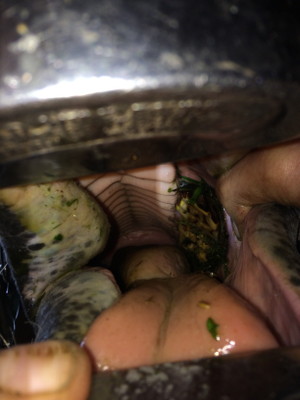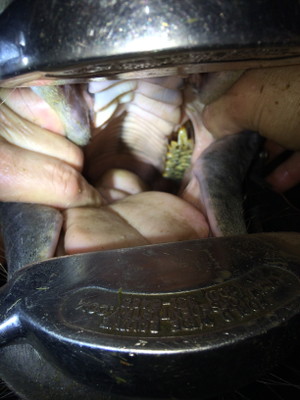Nutrition: Dental Visit Case Study Elegance CF 2001gm
The equine dentist I have been using for the past 4 years, Ron (he was recommended by my previous dentist, Larry, when he retired), visited Elegance yesterday October 9, 2015. He palpated her entire jaw line on both sides, checked how much chewing motion she had, and checked her TMJ area before he looked inside her mouth. And what he found when he did made me gasp as I looked over his shoulder. Her left upper side molars were worn at about a 45 degree angle from the inside edge of the tooth to the outside edge of the tooth. You can see all the hay packed between her molars and her cheek because she can’t move her jaw cleanly to the left without running into those upper teeth. She lacks a level chewing surface so she gets very little masticated correctly and she gives up eating sooner than a normal horse because of the pain associated with eating. Needless to say the other molars, both lower left and right side upper and lower are affected.
So you know what a normal left side molar area should look like here is the same picture of Fin DeSiecle CF 1999cm taken during the same visit:
He needs to return with my vet in attendance to sedate her in a particular way so he can begin remodeling her molars using his power instruments.
The dental pathology she exhibits has been a work in progress for many years. Whoever did the floating on this mare throughout her life didn’t attend to the wedge as it began to develop. This is through no fault of the previous owner. We pay professionals to keep our horses in the best health we can. We shouldn’t have to be equine dental experts to make sure whoever is working on our horse’s teeth is knowledgable and/or doesn’t have an ego that gets in the way of proper treatment.
I’ll say it again, a horse that eats with it’s neck stretched forward and not down, and/or packs food in the side of the cheek, and/or drops grain all over the place has a problem somewhere that is causing chewing to be uncomfortable. Dental problems are the likely culprit. It isn’t natural for a horse to eat with its head elevated and neck stretched forward moving food around in it’s mouth in order to chew it. They are trying to tell you something. Don’t be shy about getting a second opinion and don’t be shy about looking outside the box.

